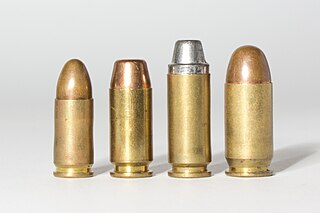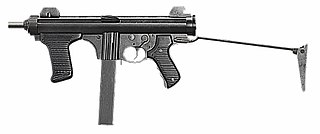
A carbine is a long gun that has a barrel shortened from its original length. Most modern carbines are rifles that are compact versions of a longer rifle or are rifles chambered for less powerful cartridges.

A submachine gun (SMG) is a magazine-fed automatic carbine designed to fire handgun cartridges. The term "submachine gun" was coined by John T. Thompson, the inventor of the Thompson submachine gun, to describe its design concept as an automatic firearm with notably less firepower than a machine gun. As a machine gun must fire rifle cartridges to be classified as such, submachine guns are not considered machine guns.

The .45 ACP, also known as .45 Auto, .45 Automatic, or 11.43×23mm is a rimless straight-walled handgun cartridge designed by John Moses Browning in 1904, for use in his prototype Colt semi-automatic pistol. After successful military trials, it was adopted as the standard chambering for Colt's M1911 pistol. The round was developed due to a lack of stopping power experienced in the Moro Rebellion in places like Sulu. The issued ammunition, .38 Long Colt, had proved inadequate, motivating the search for a better cartridge. This experience and the Thompson–LaGarde Tests of 1904 led the Army and the Cavalry to decide that a minimum of .45 caliber was required in a new handgun cartridge.

The .380 ACP, is a rimless, straight-walled pistol cartridge developed by firearms designer John Moses Browning. The cartridge headspaces on the mouth of the case. It was introduced in 1908 by Colt, for use in its new Colt Model 1908 pocket hammerless semi-automatic, and has been a popular self-defense cartridge ever since, seeing wide use in numerous handguns. Other names for .380 ACP include .380 Auto, 9×17mm, 9mm Browning, 9mm Corto, 9mm Kurz, 9mm Short, and 9mm Browning Court. It should not be confused with .38 ACP. The .380 ACP does not strictly conform to cartridge naming conventions, named after the diameter of the bullet, as the actual bullet diameter of the .380 ACP is .355 inches.

The 9×19mm Parabellum is a rimless, tapered firearms cartridge.

The 7.62×25mm Tokarev cartridge is a Soviet rimless bottleneck pistol cartridge widely used in former Soviet states and in China, among other countries. The cartridge has since been replaced in most capacities by the 9×18mm Makarov in Russian service.

The Moschetto Automatico Revelli-Beretta Mod. 1915 was a self-loading carbine that entered service in 1918 with the Italian armed forces. Designed as a semi-automatic carbine, the weapon came with an overhead inserted magazine, an unconventional design based on the simplicity of allowing a spent round to be replaced using assistance from gravity. The gun was made from half of a Villar-Perosa aircraft submachine gun.

The Beretta M12 is a 9×19mm Parabellum caliber submachine gun designed by Beretta. Production started in 1959, the first users were the Italian Carabinieri, Italian State Police and the Guardia di Finanza, though in limited numbers; it was only widely issued beginning in 1978, replacing the old Beretta MAB. In 1962 the Italian Army bought a limited number of Franchi LF-57 submachine guns, judged better than the M12 but never issued to the troops, and only in 1992 the M12S2 variant was introduced, in very limited numbers. The Italian Air Force, instead bought many M12S and M12S2 for the airport security units. However, the weapon had a higher initial success in the Arab countries and South America.

The Beretta Cx4 Storm is a pistol-calibre semi-automatic carbine aimed at the sporting, personal defense and law enforcement markets. It was designed to accept magazines from different Beretta pistol platforms using adapters. The CX4 is available in 9×19mm Parabellum, .40 S&W, .45 ACP, and 9×21mm models. The .45 model can only use 8000 "Cougar" magazines.

The Pistola Mitragliatrice Fiat Mod. 1915, commonly nicknamed the Villar Perosa, was an Italian portable automatic weapon developed during World War I by the Officine di Villar Perosa.

A handgun is a firearm designed to be usable with only one hand. It is distinguished from a long gun which needs to be held by both hands and braced against the shoulder. Handguns have shorter effective ranges compared to long guns, and are much harder to shoot accurately. While most early handguns are single-shot pistols, the two most common types of handguns used in modern times are revolvers and semi-automatic pistols, although other handguns such as derringers and machine pistols also see infrequent usage.

The Carabinetta Automatica O.V.P was a submachine gun developed in Italy.

The Glisenti Model 1910 was a 9 mm calibre semi-automatic service pistol produced by the Italian company Società Siderurgica Glisenti. It was put in production in 1910 to replace the aging Bodeo Model 1889. It saw extensive service in World War I and World War II with the Royal Italian Army. The Model 1910 has a complex and weak firing system which mandates that the pistol ought to use weaker cartridges than pistols of comparable calibre.
Chiappa Firearms, Armi Sport di Chiappa, is an Italian firearms manufacturing company based in Brescia. It was founded in 1958 by Ezechiele Chiappa as Armi Sport. Total unit production is around 60,000 per year. Its U.S. headquarters are in Dayton, Ohio.

The 7.65×21mm Parabellum is a pistol cartridge that was introduced in 1898 by German arms manufacturer Deutsche Waffen- und Munitionsfabriken (DWM) for their new Pistol Parabellum. The primary developers of the pistol cartridge were firearms designers Georg Luger and Hugo Borchardt, who developed the round from the earlier 7.65×25mm Borchardt while working at DWM.

The Beretta Model 1923 pistol was a service pistol used by the Italian Army from 1923 until 1945. The M1923 was designed to consolidate the improvements of the 1915/19 model and to use the 9mm Glisenti round. However, due to the vast amount of handguns available after the end of World War I only 3000 samples, of about 10.000 produced, were purchased by the Italian Army.

9mm P.A., 9×22mm or 9mm P.A.K. is a firearm cartridge for a non-lethal gas pistol noisemaking gun. Caliber 9mm P.A. includes various blank, gas or rubber ammunitions made for different use.

The Medusa Model 47 is a revolver manufactured by Phillips & Rodgers Inc. of Huntsville, Texas, in the late 1990s. Based on the Smith & Wesson K frame, it is notable for being capable of chambering and firing approximately 25 different cartridges within the 9 mm caliber family, such as: .357 Magnum, .38 Special, .380 ACP, and 9×19mm Parabellum. While smaller diameter cartridges can be fired, accuracy suffers. The revolver was not a commercial success and the company that produced them ceased operations after just a few hundred units were made.

The Beretta Model 1915 or Beretta M1915 is a semi-automatic pistol manufactured by Beretta, designed by Tullio Marengoni who was the chief engineer in the company, to replace the Glisenti Model 1910 which had a complex and weak firing mechanism. It is the first semi-automatic pistol, manufactured by the company, and issued as a service pistol in Royal Italian Army during World War I. The total production of the Beretta M1915 is estimated about 15,670 during 1915-1918, and about 56,000 of Beretta M1915/1917. Some of the pistols were also used in World War II until 1945. Its open slide design later became the characteristic for other Beretta pistols such as Beretta M1923, Beretta M1934, Beretta M1935, Beretta M1951, Beretta 70, Beretta 92, Beretta Cheetah, and Beretta M9.


















